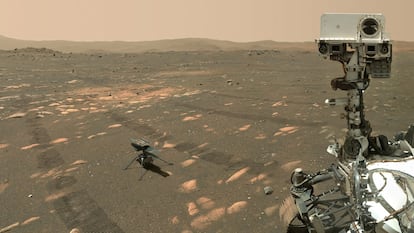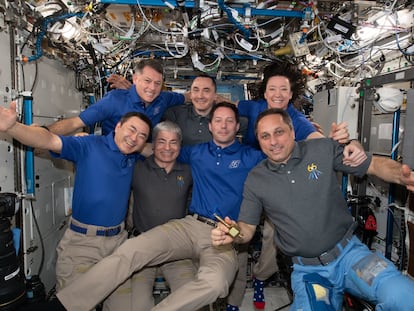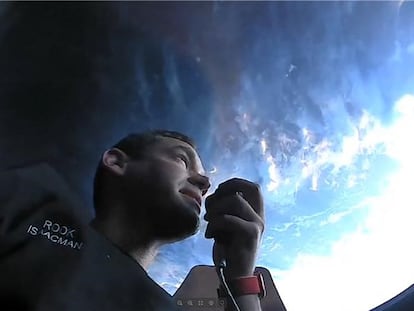Sound has two different speeds on Mars, NASA rover finds
A study of sound waves recorded by ‘Perseverance’ shows that lower-frequency sounds travel more slowly on the red planet than higher ones
On February 18, 2021, NASA’s Perseverance rover posed on Mars. A week later, earthlings could, for the first time, hear Martian sounds, on that occasion the wind. Now, a year and nearly five hours of recordings later, a recently published study has revealed all of the secrets about how the Red Planet sounds. There, the sound waves travel slower, and they fade slower. There is not one speed of sound, but two: the higher frequencies and the lower ones travel at different speeds. This data is helping scientists to better understand the Martian atmosphere, which will be key knowledge for when humans get there.
Perseverance is the most-ambitious mission ever sent to Mars. The machine itself is a wonder of technology. The main objective of the rover is to take samples, which it packages up and leaves behind like milestones on its path across the Jezero crater. It is going at its own pace, and this year has barely traveled three kilometers and collected seven of the more than 40 samples it is due to collect.
Within a decade, it is estimated that this material will be brought back to Earth, thus completing the mission: looking for signs of the life that was supposed to be on the red planet 3.5 billion years ago. Among its seven instruments are two microphones. They are far from basic, but they are the type that anyone could buy in a store. One is incorporated into the camera system in the Entry, Descent and Landing (EDL) system, and it is recording the noise that the six wheels make as they travel. The other accompanies the SuperCam instrument, which is installed on the mast of Perseverance and records the ambient noise every few minutes. But someone from the University of Málaga (UMA) in southern Spain had an idea that no one else had thought of: the rover could record the sound made by its laser when it cuts through the Martian rocks.
A team led by UMA professor Javier Laserna has provided the NASA mission with a spectroscopy system to analyze the light signal emitted by the laser. The ray cuts for a few seconds, and during that time it emits a light. The spectrum of this light can be analyzed to find out what the rock is made of, but it also makes a noise. As César Álvarez, from Laserna’s team, points out, “the SuperCam microphone is synchronized with the laser, and during those seconds you can hear a sound as the rock is excised.” His colleague, Javier Amorós, also from the UMA and coauthor of the study, says that “if you know the distance of the rock, you can measure the speed of the sound.”
The results of this year of recording sounds have just been published in science magazine Nature. While this is not completely new for experts in acoustics, given that it had already been done with models on Earth, the most striking finding is that the speed of sound is different according to the frequency.
Mars is very quiet, and before the rovers, there was just the sound of the windJosé Antonio Rodríguez, from Spain‘s Astrobiology Center
According to the models, knowing the atmospheric pressure – which on the Martian planes is around 100 times lower than on Earth at sea level – and the physical properties of the environment – carbon dioxide predominates in the Martian atmosphere – the estimate was that the sound waves would move at around 240 meters per second compared to 342 on Earth. The modeling was not too far off.
The speed of sound during the day varies from 240m/s to 257m/s. And the variations correspond to the frequency: the highest, above 2kHz, travel up to 257m/s. Meanwhile, low frequencies, those around 84Hz, move slower, at around 240m/s. While hypothetical, a conversation between two people barely five meters apart would simply cause an unintelligible cacophony.
For the authors of the study, the different attenuation with respect to the Earth is the most striking property of sound on Mars. The lower density of the planet’s atmosphere makes the attenuation much greater than on the surface of the Earth. Understood as the loss of power of the original signal as it travels through a medium, the physics of this process are relatively simple: as the sound wave moves through the air, molecules bump into each other, oscillating and generating heat. Part of the acoustic energy dissipates in the medium. The fascination of this process is explained by physicist Manuel de la Torre, a researcher from the NASA Jet Propulsion Laboratory, which is behind the Perseverance mission. “I thought it was interesting how the microphone captured the rhythm of the dissipation of the energy from the atmosphere to heat in a very thin atmosphere that is rich in CO₂. You can even hear the scale where the movement reaches the size of the distance between the molecules. It’s a dynamic system that is difficult to measure on the Earth.”
But the sound of Mars is not just interesting by itself. The recordings of the wind, the wheels and the laser are serving as a mirror of the medium: the Martian atmosphere. The Mars Environmental Dynamics Analyzer (MEDA), one of Perseverance’s instruments, is in charge of studying this. MEDA is an advanced meteorological station, and its main researcher is José Antonio Rodríguez, from the Astrobiology Center (CAB), which is part of Spain’s National Institute of Aerospace Technology. “Mars is very quiet, and before the rovers, there was just the sound of the wind,” Rodríguez explains. During the day, convective turbulence is produced in the layer closest to the surface, marked by the vertical movement of the air caused by sunshine and an unstable thermal gradient. “The recordings allow us to study the variations within these gusts. We are doing the turbulence study with MEDA, with data on temperature, pressure… but the sound has permitted this on a micro level,” the Spanish scientist adds.
Compared to the millions of weather stations there are on Earth, on Mars, there are only three – all of whom are Spanish. As well as the other data they are collecting, we can now add the sound recorded by Perseverance. As Rodríguez explains, “these stations and the microphone data allow us to refine the models, and get to know the dynamics of the atmosphere better to design future missions.”
Tu suscripción se está usando en otro dispositivo
¿Quieres añadir otro usuario a tu suscripción?
Si continúas leyendo en este dispositivo, no se podrá leer en el otro.
FlechaTu suscripción se está usando en otro dispositivo y solo puedes acceder a EL PAÍS desde un dispositivo a la vez.
Si quieres compartir tu cuenta, cambia tu suscripción a la modalidad Premium, así podrás añadir otro usuario. Cada uno accederá con su propia cuenta de email, lo que os permitirá personalizar vuestra experiencia en EL PAÍS.
¿Tienes una suscripción de empresa? Accede aquí para contratar más cuentas.
En el caso de no saber quién está usando tu cuenta, te recomendamos cambiar tu contraseña aquí.
Si decides continuar compartiendo tu cuenta, este mensaje se mostrará en tu dispositivo y en el de la otra persona que está usando tu cuenta de forma indefinida, afectando a tu experiencia de lectura. Puedes consultar aquí los términos y condiciones de la suscripción digital.
More information
Últimas noticias
NASA discovers Titan doesn’t have an ocean, but a ‘slushy ice layer’ that increases possibility of life
Innocence lost in the forest of the child soldiers: ‘Each leader of the armed group had his girls’
‘Fallout’ or how the world’s largest company turned an anti-capitalist apocalyptic Western into a phenomenon
From inflation to defending migrants: Eileen Higgins and Zohran Mamdani inaugurate the new Democratic resistance against Trump
Most viewed
- ‘El Limones’ and the growing union disguise of Mexican organized crime
- Christian Louboutin: ‘Young people don’t want to be like their parents. And if their parents wear sneakers, they’re going to look for something else’
- The low-cost creative revolution: How technology is making art accessible to everyone
- ‘We are dying’: Cuba sinks into a health crisis amid medicine shortages and misdiagnosis
- A mountaineer, accused of manslaughter for the death of his partner during a climb: He silenced his phone and refused a helicopter rescue












































